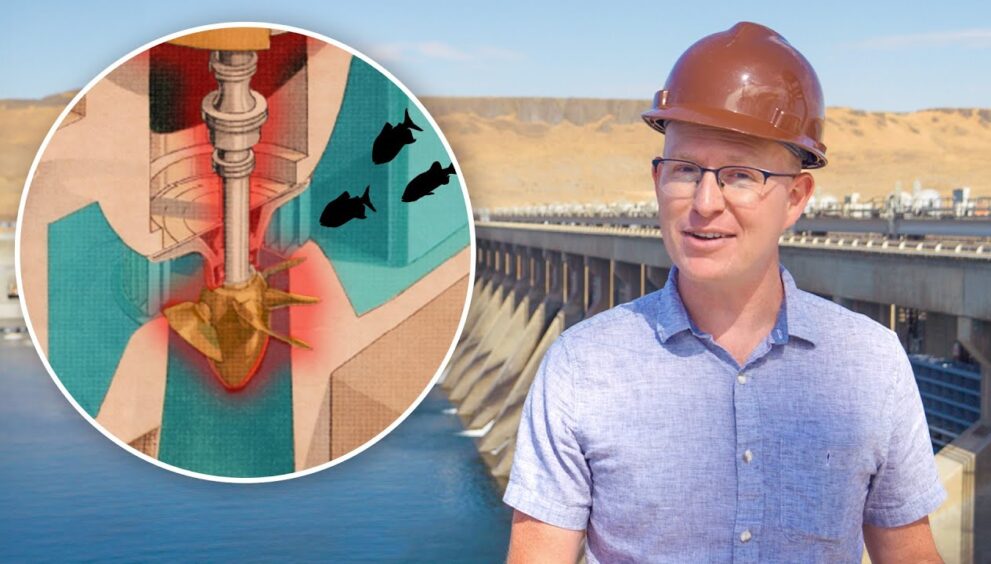Dams and Environmental Impacts: How Fish Survive Hydro Turbines

Introduction
Most of the largest dams in the US were built before we really understood the impacts they would have on river ecosystems. Or at least they were built before we were conscientious enough to weigh those impacts against the benefits of a dam. And, to be fair, it’s hard to overstate those benefits: flood control, agriculture, water supply for cities, and hydroelectric power. All of our lives benefit in some way from this enormous control over Earth’s freshwater resources. But those benefits come at a cost, and the price isn’t just the dollars we’ve spent on the infrastructure but also the impacts dams have on the environment. So you have these two vastly important resources: the control of water to the benefit of humanity and aquatic ecosystems that we rely on, and in many ways these two are in direct competition with each other. But even though most of these big dams were built decades ago, the ways we manage that struggle are constantly evolving as the science and engineering improve.
Striking a Balance
This is a controversial issue with perspectives that run the gamut. And I don’t think there’s one right answer, but I do know that an informed opinion is better than an oblivious one. So, I wanted to see for myself how we strike a balance between a dam’s benefits and environmental impacts, and how that’s changing over time. So, I partnered up with the folks at the Pacific Northwest National Laboratory (or PNNL) in Washington state to learn more. Just to be clear, they didn’t sponsor this video and had no control over its contents. They showed me so much, not just the incredible technology and research that goes on in their lab, but also how it is put into practice in real infrastructure in the field, all so I could share it with you.
The McNary Dam: A Hydroelectric Powerhouse
This is McNary Dam, a nearly 1.5-mile-long hydroelectric dam across the Columbia River between Oregon and Washington state, just shy of 300 miles (or 470 km) upriver from the Pacific Ocean. And this is Tim Roberts, the dam’s Operations Project Manager and the best dam tour guide I’ve ever met. But this was not just a little walkthrough. We went deep into every part of this facility to really understand how it works. McNary is one of the hydropower workhorses in the Columbia River system, a network of dams that provide electricity, irrigation water, flood control, and navigation to the region. It’s equipped with fourteen power-generating turbines, and these behemoths can generate nearly a gigawatt of power combined! That means this single facility can, very generally, power more than half-a-million homes. The powerhouse where those turbines live is nearly a quarter mile long (more than 350 meters)! It’s pretty hard to convey the scale of these units in a video, but Tim was gracious enough to take us down inside one to see and hear the enormous steel shaft spinning as it generates megawatts of electrical power. All that electricity flows out to the grid on these transmission lines to power the surrounding area.
Fish Passage Structures
McNary is a run-of-the-river dam, meaning it doesn’t maintain a large reservoir. It stores some water in the forebay to create the height needed to run the turbines, but water flows more or less at the rate it would without the dam. So, any extra water flowing into the forebay that can’t be used for hydro generation has to be passed downstream through one or more of these 22 enormous lift gates in the spillway beside the powerhouse.
As you can imagine, all this infrastructure is a lot to operate and maintain. But it’s not just hydrologic conditions like floods and droughts or human needs like hydropower demands and irrigation dictating how and when those gates open or when those turbines run; it’s biological criteria too. The Columbia and its tributaries are home to a huge population of migratory fish, including chinook, coho, sockeye, pink salmon, and lampreys, and over the years, through research, legislation, lawsuits, advocacy, and just plain good sense by the powers that be, we’ve steadily been improving the balance between impacts to that wildlife and the benefits of the infrastructure. In fact, just about every aspect of the operation of McNary Dam is driven by the Fish Passage Plan. This 500-page document, prepared each year in collaboration with a litany of partners, governs the operation of McNary and several other dams in the Columbia River system to improve the survival of fish along the river. This fish bible includes prescriptive details and schedules for just about every aspect of the dam, including the fish passage structures too.
On top of the hydropower plant and the spillway, McNary is equipped with a host of facilities meant to help wildlife get from one side to the other with as little stress or injury as possible.
Fish Ladders
McNary has two fish ladders, one on each side. These ladders are designed to encourage and allow adult salmon and other species from the ocean to swim upstream to reproduce in freshwater streams. The fish ladders at McNary use attraction water, where huge electric pumps lift water from the tailrace below the dam and discharge it into a channel that runs along the powerhouse. As the water splashes back down, it draws fish toward the entrances so they can orient with the flow through the ladder. Concrete baffles break up the insurmountable height of the dam into manageable sections that fish can swim up at their own pace. Most of the fish go through holes in the baffles, but some jump over the weirs. There’s even a window near the top of the ladder where an expert counts the fish and identifies their species. This data is important to a wide variety of organizations, and it’s even posted online if you want to have a look. Once at the top, the fish pass through a trash rack that keeps debris out of the ladder and continue their journey to their spawning grounds.
Juvenile Fish Passage
McNary Dam needs a way to get juvenile fish downstream. Juvenile fish can make it through the spillway mostly just fine. In fact, specialized structures are often installed during peak migration times to encourage fish to swim through the spillway. McNary Dam has lift gates where the water flows from lower in the water column. Many dams on the Columbia system have some way to spill water over the top, called a weir, that is more conducive to getting the juveniles through the dam. The other path for juveniles to take is to be drawn toward the turbines. But McNary and a lot of other dams are equipped with a sophisticated bypass system to divert the fish before they make it that far, and that all starts with the submersible screens. These enormous structures are specially designed with lots of narrow slots to let as much water through to the turbines while excluding juvenile fish. They are lowered into place with the huge gantry crane that rides along the top of the powerhouse. Once the fish have been diverted by the screens, they flow with some of the water upward into a massive collection channel. Then they flow along the channel, while grates along the bottom concentrate them upward. Next, they flow into a huge pipe that pops out on the downstream face of the dam. Along the way, the juveniles pass through electronic readers that scan any of the fish that have been equipped with tags and then into a maze of pipes and valves and pumps and flumes. In the past, this facility was used to store juveniles so they could be loaded up in barges and transported downstream. But over time, the science showed it was better to just release them downstream from the dam. Every once in a while, some of the juveniles are separated for counting so scientists can track them just like the adults in the ladder. Then the juveniles continue their journey in the pipe out to the middle of the river downstream. Avian predation is a serious problem for juveniles, so McNary is equipped with a lot of deterrents to try and keep the birds away.
The Constant Improvement of Science
All this infrastructure at McNary Dam to help fish get upstream and downstream has changed and evolved over time, and in fact, a lot of it wasn’t even conceived of when the dam was first built. And that’s one of the most important things I learned touring McNary Dam and the Pacific Northwest National Lab: the science is constantly improving. A ton of that science happens at the PNNL Aquatics Research Laboratory. For example, PNNL has developed sensor fish, electronic analogues to real fish that they can send through turbines and get data out on the other side. Compare that data to what we already know about the limits fish can withstand, and you can quickly and safely evaluate the impacts a turbine can have. What’s awesome is seeing how that research translates into actual investments in infrastructure that have a huge effect on survivability. New turbines recently installed at Ice Harbor Dam upstream were designed in collaboration with PNNL with fish passage in mind to reduce injury for any juveniles that find their way in. And it’s not just the turbines that are seeing improvements. Researchers at PNNL study live fish, how they navigate different kinds of structures, and what they can withstand. They also explore innovative ways to reduce biological buildup on nets and screens, as well as new ways to operate turbines to decrease impacts to fish from ramping them up and down in response to fluctuating grid demands. They have even developed a suite of sensors that can be implanted into fish for a variety of purposes, such as tracking their movement and behavior.
The Balancing Act Continues
Of course, migratory fish aren’t the only part of the environment impacted by hydropower, and with all the competing interests, I don’t think we’ll ever feel like the issue is fully solved. These are messy, muddy questions that take time, energy, and big investments in resources to get even the simplest answers. The salmon pink and blue paint in the powerhouse at McNary really sums it up well, with the blue symbolizing the water that drives the station, and the pink symbolizing the life within the water, and its environmental, economic, and cultural significance. This kind of balancing act is really at the heart of what a lot of engineering is all about. I’m so grateful for the opportunity to see and learn more about how energy researchers, biologists, ecologists, policy experts, regulators, activists, and engineers collaborate to make sure we’re being good stewards of the resources we depend on.
Conclusion
Dams and their impacts on the environment are a complex and ongoing issue. Balancing the benefits of dams, such as flood control and hydroelectric power, with the preservation of aquatic ecosystems is a challenging task. However, through continuous scientific research and engineering advancements, we are constantly improving our understanding and management of this struggle. The case of McNary Dam and the work done by the Pacific Northwest National Laboratory demonstrate the importance of considering environmental impacts and implementing measures to mitigate them. While the issue is far from being fully resolved, the ongoing efforts of researchers, engineers, and policymakers offer hope for a more sustainable future.


























































































































































































































































































































































































































































































































































































































































![Fixing [pii_email_aa0fea1a78a192ae7d0f] Microsoft Outlook Error](https://www.huffenpost.com/wp-content/uploads/2023/03/What-Causes-the.jpg)
![Fixing [pii_email_aa0fea1a78a192ae7d0f] Microsoft Outlook Error](https://www.huffenpost.com/wp-content/uploads/2023/03/How-to-fix-the-1-1024x1024.webp)
![Quick fixes for the [pii_email_dbd9dd084703ead3b9cf] Mail Error](https://www.huffenpost.com/wp-content/uploads/2023/03/How-to-Avoid-pii_email_b6b14f95f44a83737071-Outlook-Error-1024x576.jpg)
![How to fix the [pii_email_bbf95bff57a974a71da8] in Microsoft Outlook?](https://www.huffenpost.com/wp-content/uploads/2023/03/How-To-Solve-The-pii_email_9e750e335dfd9d75badb-Outlook-Error.webp)
![How to solve the [pii_email_b6b14f95f44a83737071] Outlook Error](https://www.huffenpost.com/wp-content/uploads/2023/03/How-to-Avoid-pii_email_b6b14f95f44a83737071-Outlook-Error.png)
![Ways to fix the "[pii_email_1fb861393abed78ab415] Error](https://www.huffenpost.com/wp-content/uploads/2023/03/pii_pn_56e685559f213991c933-Error-Causes-and-Solutions2.jpg)
![How to Fix the [pii_email_e2f55b4aa7bb667da6d9] Error](https://www.huffenpost.com/wp-content/uploads/2023/03/How-to-fix-the.webp)
![What Everyone Should Know About [pii_email_59ea919492dfc2762030]](https://www.huffenpost.com/wp-content/uploads/2023/03/pii_email_aa0fea1a78a192ae7d0f-Email-Error-and-Its-Solutions-1024x683.jpg)
![How to Fix the [pii_pn_5359771d15a46e7b88bf] Outlook Email Error](https://www.huffenpost.com/wp-content/uploads/2023/03/pii_email_57a4a2f20ec6813a8481-SMTP-Error-Solution-2.jpg)


























































































